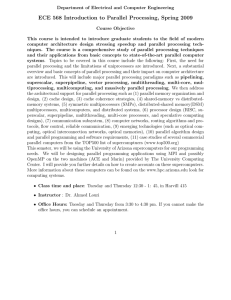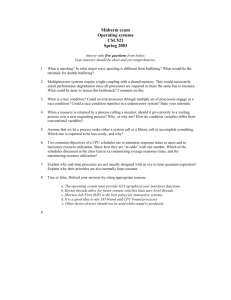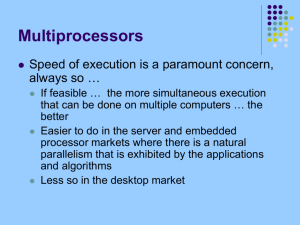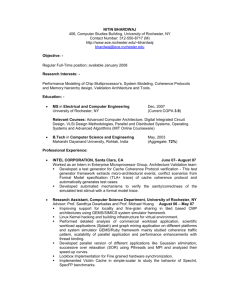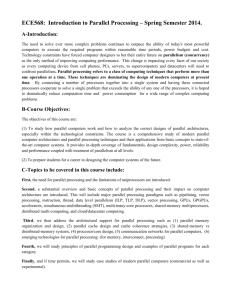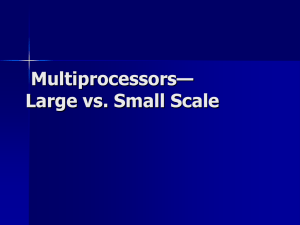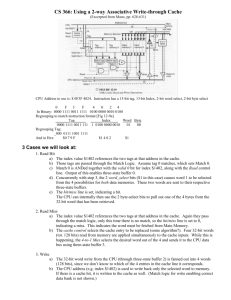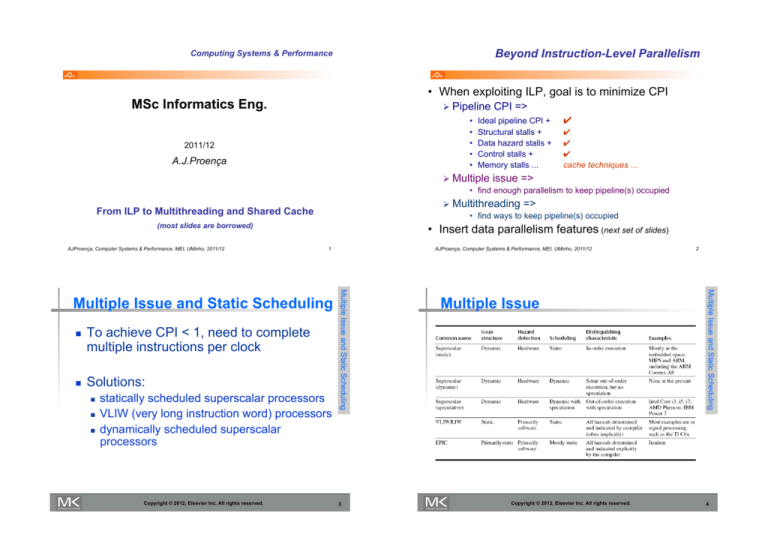
Beyond Instruction-Level Parallelism
Computing Systems & Performance
• When exploiting ILP, goal is to minimize CPI
MSc Informatics Eng.
! Pipeline
•
•
•
•
•
2011/12
A.J.Proença
CPI =>
Ideal pipeline CPI +
Structural stalls +
Data hazard stalls +
Control stalls +
Memory stalls ...
!
!
!
!
cache techniques ..."
! Multiple issue =>
• find enough parallelism to keep pipeline(s) occupied
! Multithreading =>
• find ways to keep pipeline(s) occupied
From ILP to Multithreading and Shared Cache
(most slides are borrowed)
AJProença, Computer Systems & Performance, MEI, UMinho, 2011/12
• Insert data parallelism features (next set of slides)
1
"
To achieve CPI < 1, need to complete
multiple instructions per clock
Solutions:
"
"
"
statically scheduled superscalar processors
VLIW (very long instruction word) processors
dynamically scheduled superscalar
processors
Copyright © 2012, Elsevier Inc. All rights reserved.
3
Multiple Issue
Copyright © 2012, Elsevier Inc. All rights reserved.
2
Multiple Issue and Static Scheduling
"
Multiple Issue and Static Scheduling
Multiple Issue and Static Scheduling
AJProença, Computer Systems & Performance, MEI, UMinho, 2011/12
4
"
Performing multiple threads of execution in
parallel
"
"
"
Fine-grain multithreading
"
"
"
"
Replicate registers, PC, etc.
Fast switching between threads
§7.5 Hardware Multithreading
Multithreading
"
"
In multiple-issue dynamically scheduled
processor
"
"
Switch threads after each cycle
Interleave instruction execution
If one thread stalls, others are executed
Coarse-grain multithreading
"
Simultaneous Multithreading
"
"
Only switch on long stall (e.g., L2-cache miss)
Simplifies hardware, but doesn’t hide short stalls
(eg, data hazards)
Schedule instructions from multiple threads
Instructions from independent threads execute
when function units are available
Within threads, dependencies handled by
scheduling and register renaming
Example: Intel Pentium-4 HT
"
Two threads: duplicated registers, shared
function units and caches
Chapter 7 — Multicores, Multiprocessors, and Clusters — 5
Instruction and Data Streams
"
An alternate classification
Data Streams
Single
Instruction Single
Streams
Multiple
"
SISD:
Intel Pentium 4
SIMD: SSE
instructions of x86
MISD:
No examples today
MIMD:
Intel Xeon e5345
SPMD: Single Program Multiple Data
"
"
Chapter 7 — Multicores, Multiprocessors, and Clusters — 7
Multiple
§7.6 SISD, MIMD, SIMD, SPMD, and Vector
Multithreading Example
Chapter 7 — Multicores, Multiprocessors, and Clusters — 6
A parallel program on a MIMD computer
Conditional code for different processors
Chapter 7 — Multicores, Multiprocessors, and Clusters — 8
Thread-Level parallelism
"
"
"
"
"
Have multiple program counters
Uses MIMD model
Targeted for tightly-coupled shared-memory
multiprocessors
"
"
"
"
"
"
Time Event
step
CPU A’s
cache
CPU B’s
cache
0
Memory
0
1
CPU A reads X
0
0
2
CPU B reads X
0
0
0
3
CPU A writes 1 to X
1
0
1
Chapter 5 — Large and Fast: Exploiting Memory Hierarchy — 11
Memory distributed among
processors
Non-uniform memory access/
latency (NUMA)
Processors connected via
direct (switched) and nondirect (multi-hop)
interconnection networks
Copyright © 2012, Elsevier Inc. All rights reserved.
10
Cache Coherence
"
Coherence
"
"
"
All reads by any processor must return the most
recently written value
Writes to the same location by any two processors are
seen in the same order by all processors
Consistency
"
"
Centralized Shared-Memory Architectures
Write-through caches
§5.8 Parallelism and Memory Hierarchies: Cache Coherence
Suppose two CPU cores share a physical
address space
Small number of cores
Share single memory with
uniform memory latency
Distributed shared memory
(DSM)
9
Cache Coherence Problem
"
Symmetric multiprocessors
(SMP)
"
Threads can be used for data-level
parallelism, but the overheads may outweigh
the benefit
Copyright © 2012, Elsevier Inc. All rights reserved.
"
Types
For n processors, need n threads
Amount of computation assigned to each
thread = grain size
"
Introduction
"
Introduction
Introduction to multithreading
When a written value will be returned by a read
If a processor writes location A followed by location B,
any processor that sees the new value of B must also
see the new value of A
Copyright © 2012, Elsevier Inc. All rights reserved.
12
"
Operations performed by caches in
multiprocessors to ensure coherence
"
"
On write, invalidate all other copies
Use bus itself to serialize
Reduces bandwidth for shared memory
"
Write cannot complete until bus access is obtained
Reduces contention for access
Snooping protocols
"
"
"
Replication of read-shared data
"
"
Write invalidate
Migration of data to local caches
"
"
"
Each cache monitors bus reads/writes
Directory-based protocols
"
Caches and memory record sharing status of
blocks in a directory
"
Write update
"
On write, update all copies
Chapter 5 — Large and Fast: Exploiting Memory Hierarchy — 13
Locating an item when a read miss occurs
"
"
In write-back cache, the updated value must
be sent to the requesting processor
Cache lines marked as shared or
exclusive/modified
"
Only writes to shared lines need an invalidate
broadcast
"
Centralized Shared-Memory Architectures
Snoopy Coherence Protocols
"
Centralized Shared-Memory Architectures
Snoopy Coherence Protocols
Cache Coherence Protocols
After this, the line is marked as exclusive
Copyright © 2012, Elsevier Inc. All rights reserved.
15
Copyright © 2012, Elsevier Inc. All rights reserved.
14
Invalidating Snooping Protocols
"
Cache gets exclusive access to a block
when it is to be written
"
"
Broadcasts an invalidate message on the bus
Subsequent read in another cache misses
"
Owning cache supplies updated value
CPU activity
Bus activity
CPU A’s
cache
CPU A reads X
Cache miss for X
0
CPU B reads X
Cache miss for X
0
CPU A writes 1 to X
Invalidate for X
1
CPU B read X
Cache miss for X
1
CPU B’s
cache
Memory
0
0
0
0
0
1
1
Chapter 5 — Large and Fast: Exploiting Memory Hierarchy — 16
"
Complications for the basic MSI protocol:
"
Operations are not atomic
"
"
"
"
E.g. detect miss, acquire bus, receive a response
Creates possibility of deadlock and races
One solution: processor that sends invalidate can
hold bus until other processors receive the
invalidate
Extensions:
"
Add exclusive state to indicate clean block in
only one cache (MESI protocol)
"
"
Centralized Shared-Memory Architectures
Snoopy Coherence Protocols
17
Prevents needing to write invalidate on a write
Owned state
Copyright © 2012, Elsevier Inc. All rights reserved.
Centralized Shared-Memory Architectures
Copyright © 2012, Elsevier Inc. All rights reserved.
Centralized Shared-Memory Architectures
Snoopy Coherence Protocols
Snoopy Coherence Protocols
Copyright © 2012, Elsevier Inc. All rights reserved.
18
Reading suggestions (from CAQA 5th Ed)
• Concepts and challenges in ILP:
section 3.1
• Exploiting ILP w/ multiple issue & static scheduling: 3.7
• Exploiting ILP w/ dyn sched, multiple issue & specul: 3.8
• Multithread: exploiting TLP on uniprocessors:
3.12
• Multiprocessor cache coherence and
snooping coherence protocol with example:
5.2
• Basics on directory-based cache coherence:
5.4
• Models of memory consistency:
5.6
• A tutorial by Sarita Ave & K. Gharachorloo (see link at website)
19
AJProença, Computer Systems & Performance, MEI, UMinho, 2011/12
20

